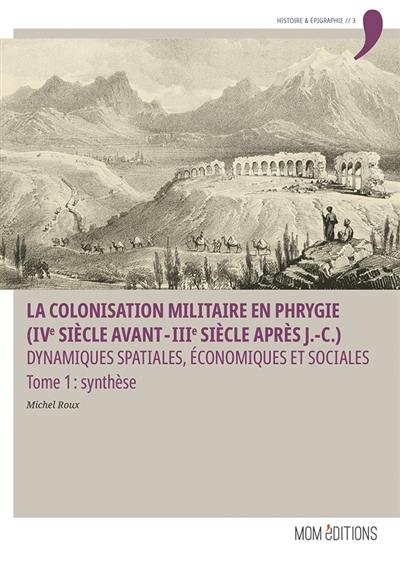
Fiche technique
Format : Broché
Nb de pages : 563 pages
Poids : 1800 g
Dimensions : 21cm X 30cm
ISBN : 978-2-35668-080-8
EAN : 9782356680808
Synthèse
Quatrième de couverture
La colonisation militaire en Phrygie (IVe siècle avant-IIIe siècle après J.-C). Dynamiques spatiales, économiques et sociales.
Tome 1 : synthèse
Au coeur d'un espace phrygien géographiquement mal défini dans l'Antiquité, l'installation de colons militaires, d'anciens soldats et de troupiers encore en activité, répondait à des objectifs stratégiques parfaitement identifiés pour les Achéménides, les monarques hellénistiques ou encore les Romains. Il s'agissait de contrôler un espace essentiel pour les communications terrestres entre l'intérieur du plateau anatolien d'une part et l'Égée d'autre part, mais aussi entre cette même côte et la Cilicie, puis au-delà la Syrie. Sur un plan tactique, cette présence militaire devait servir à protéger plateau et vallées phrygiens de la convoitise de populations voisines mal contrôlées comme les Pisidiens.
S'appuyant sur de très nombreuses sources archéologiques, numismatiques et épigraphiques, examinant chaque communauté au cas par cas, cet ouvrage étudie les conséquences de l'installation de ces militaires sur la réalité locale, que ce soit au niveau économique, culturel, religieux ou social. Parcourant un temps long allant du IVe siècle avant J.-C. jusqu'à la fin de la dynastie des Sévères, il s'efforce de peser les évolutions liées à la présence de ces soldats allogènes. Entre la Phrygie achéménide et celle hellénistique puis romaine, le faciès de la région, essentiellement rurale au départ, a progressivement évolué : dès l'époque hellénistique, on observe un phénomène de poliadisation important, rendant le réseau de communication plus dense et le contrôle des populations locales plus complexe.
Le second tome de cet ouvrage (Corpora) est disponible uniquement sur le portail OpenEdition Books.
At the heart of a geographically ill-defined Phrygian space during Antiquity, the installation of military settlers, former soldiers and troupiers still in operation, met perfectly identified strategic objectives from the Achaemenids, the Hellenistic monarchs or the Romans. It was to control a space essential for terrestrial communications between the interior of the Anatolian plateau on the one hand and the Aegean on the other, but also between this same coast and Cilicia, and then beyond Syria. On a tactical level, this military presence was to protect Phrygian plateau and valleys from the lust of poorly controlled neighboring populations like Pisidians.
Based on numerous archaeological, numismatic and epigraphic sources, examining each community on a case-by-case basis, this work studies the consequences of the installation of these soldiers on the local reality, whether at the economic level, cultural, religious or social. Covering a long period from the 4th century BC to the end of the Severan Dynasty, he endeavours to weigh the evolutions related to the presence of these alien soldiers. Between the Achemenid Phrygia and the Hellenistic and then Roman one, the aspect of the region, essentially rural at the outset, has gradually evolved : from the Hellenistic era, we observe an important phenomenon of poliadization, making the communication network more dense and the control of local populations more complex.
The second volume of this book (Corpora) is only available on the OpenEdition Books portal.






